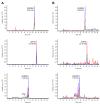Nodularia spumigena peptides--accumulation and effect on aquatic invertebrates
- PMID: 26529012
- PMCID: PMC4663510
- DOI: 10.3390/toxins7114404
Nodularia spumigena peptides--accumulation and effect on aquatic invertebrates
Abstract
Thus far, the negative effects of Nodularia spumigena blooms on aquatic organisms have been mainly attributed to the production of the hepatotoxic nodularin (NOD). In the current work, the accumulation of other N. spumigena metabolites in blue mussels and crustaceans, and their effect on Thamnocephalus platyurus and Artemia franciscana, were examined. The liquid chromatography-tandem mass spectrometry (LC-MS/MS) analyses provided evidence that both blue mussels collected after a cyanobacterial bloom in the Baltic Sea and the crustaceans exposed under laboratory conditions to N. spumigena extract accumulated the cyclic anabaenopeptins (APs). In the crustaceans, the linear peptides, spumigins (SPUs) and aeruginosins (AERs), were additionally detected. Exposure of T. platyurus and A. franciscana to N. spumigena extract confirmed the negative effect of nodularin on the organisms. However, high numbers of dead crustaceans were also recorded in the nodularin-free fraction, which contained protease inhibitors classified to spumigins and aeruginosins. These findings indicate that cyanobacterial toxicity to aquatic organisms is a complex phenomenon and the induced effects can be attributed to diverse metabolites, not only to the known hepatotoxins.
Keywords: Baltic cyanobacteria; Nodularia spumigena; bioaccumulation; blue mussels; crustaceans; cyanopeptides.
Figures



References
-
- Paerl H.W., Fulton R.S. Ecology of harmful cyanobacteria. In: Granéli E., Turner J., editors. Ecology of Harmful Algae. Volume 189. Springer; Verlag, Berlin, Germany: 2006. pp. 95–107.
Publication types
MeSH terms
Substances
LinkOut - more resources
Full Text Sources
Other Literature Sources
Molecular Biology Databases
Miscellaneous

